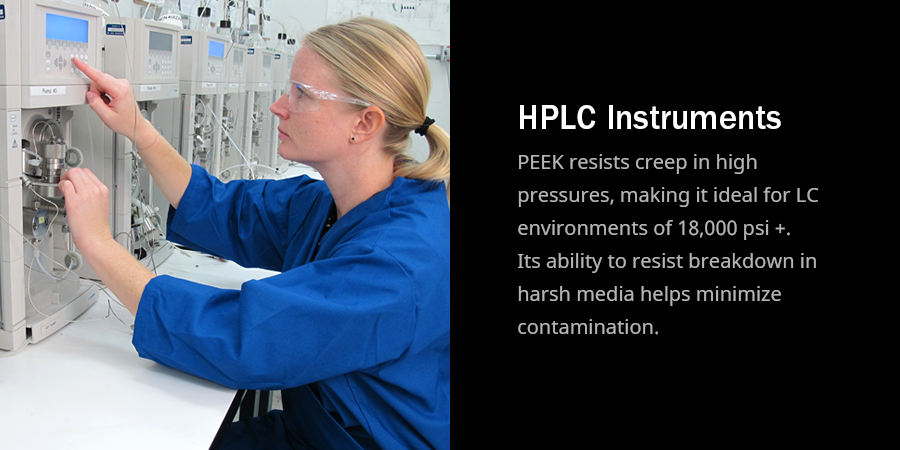
Polyetheretherketone (PEEK) has become a material of choice in analytical instrumentation, especially in high-performance liquid chromatography (HPLC) systems, due to its remarkable combination of chemical, thermal, and mechanical properties. Whether used for tubing, fittings, or other critical components, PEEK delivers a level of performance that few other materials can match, making it ideal for demanding analytical environments.
Key Benefits of PEEK in Analytical Instrumentation
1. Biocompatibility
One of the standout qualities of PEEK is its biocompatibility. PEEK does not react negatively with human tissues or fluids, which makes it not only a leading material in medical implants and instruments but also an excellent choice for instruments that need to come into contact with sensitive biological samples. Its use in clinical and laboratory settings is further supported by its inert nature.
2. Chemical Inertness
PEEK is renowned for its exceptional chemical resistance, standing up to a wide range of harsh solvents, acids, and oxidative environments. This property is critical in analytical instruments, where consistent contact with aggressive chemicals is common. The chemical inertness of PEEK ensures that there is minimal risk of contamination or reaction between the sample and the instrument components, resulting in more accurate analytical results.
3. Flexibility
PEEK tubing is incredibly flexible and can be easily cut to fit various system configurations. This makes it highly adaptable in laboratories where custom setups or frequent modifications are required. Despite its flexibility, PEEK maintains its strength and integrity under a range of physical conditions.
4. Radiolucency
PEEK is radiolucent, meaning it is transparent on X-rays, CT scans, and MRIs. This property is invaluable not only in the medical field for tracking implants during surgery but also in analytical and testing environments where non-interference with imaging techniques is necessary.
5. Resistance to Wear and Chemicals
PEEK is highly resistant to wear, fatigue, and chemical exposure. This durability makes it particularly useful in analytical systems that are subjected to long operational hours or that handle corrosive or abrasive substances. Its ability to withstand UV light further extends its applicability in diverse analytical conditions.
6. Strength and Durability
Despite its flexibility, PEEK is incredibly strong. It offers a level of mechanical strength comparable to certain metal alloys, without the drawbacks associated with corrosion or oxidation. PEEK is also resistant to peeling, making it an ideal material for long-term use in analytical instruments that demand high reliability.
7. Thermal Stability
PEEK can perform at elevated temperatures, withstanding conditions above 500°F without significant degradation. Its high thermal stability means that it can be used in high-temperature analytical methods without risk of melting, warping, or catching fire. This makes PEEK an optimal choice for instruments that require consistent performance under a wide range of thermal conditions.
Applications of PEEK in HPLC Systems
PEEK Tubing
PEEK tubing is widely used in HPLC systems due to its low cost, chemical resistance, and ease of use. Unlike metal tubing, PEEK is inert and does not react with most solvents, ensuring sample integrity. Its smooth internal surface allows for improved sample band resolution, enhancing the accuracy and precision of analytical results. Additionally, PEEK tubing is easily identifiable by its internal diameter, making system configurations simpler.
PEEK Fittings
PEEK fittings are another critical component in HPLC setups, especially when operating at pressures below 400 bar (6000 psi). PEEK unions, a common fitting type, are one-piece, finger-tight connectors that do not require additional ferrules. These fittings are versatile, durable, and available in various bore sizes to suit different HPLC system needs.
Potential Challenges
Despite its many advantages, PEEK is not without some limitations. Tubing slippage can occur in PEEK fittings if the system experiences overpressure or if leaks develop at the fitting point. This issue is typically preventable by maintaining appropriate pressure levels and ensuring proper fitting connections during system assembly.
Conclusion
PEEK stands out as a versatile and reliable material in the field of analytical instrumentation. Its unique combination of biocompatibility, chemical resistance, strength, and thermal stability makes it an ideal choice for high-performance applications such as HPLC systems. While it is important to be aware of potential challenges like tubing slippage, the overall benefits of PEEK far outweigh its limitations, making it a preferred material for engineers and scientists working in demanding analytical environments.